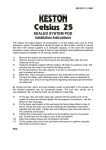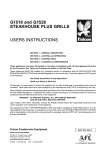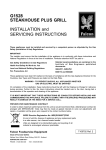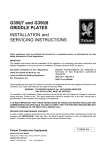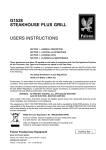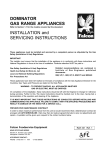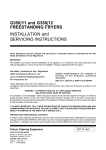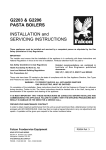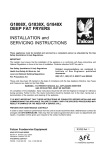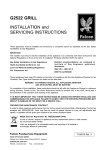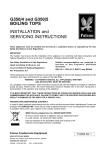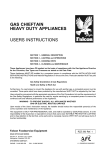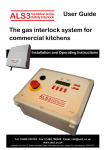Download G1528!Service Manual
Transcript
G1518 and G1528 G1518P and G1528P STEAKHOUSE PLUS GRILLS INSTALLATION and SERVICING INSTRUCTIONS These Appliances must be installed and serviced by a competent person as stipulated by the Gas Safety (Installation & Use) Regulations. IMPORTANT The installer must ensure that the installation of the appliance is in conformity with these instructions and National Regulations in force at the time of installation. Particular attention MUST be paid to - Gas Safety (Installation & Use) Regulations Health And Safety At Work etc. Act Local and National Building Regulations Fire Precautions Act Detailed recommendations are contained in Institute of Gas Engineers published documents : IGE/ UP/ 1, IGE/ UP/ 2, BS6173 and BS5440 These Appliances have been CE-marked on the basis of compliance with the Gas Appliance Directive for the Countries, Gas Types and Pressures as stated on the Data Plate. WARNING - TO PREVENT SHOCKS, ALL APPLIANCES WHETHER GAS OR ELECTRIC, MUST BE EARTHED On completion of the installation, these instructions should be left with the Engineer-in-Charge for reference during servicing. Further to this, The Users Instructions should be handed over to the User, having had a demonstration of the operation and cleaning of the appliance. IT IS MOST IMPORTANT THAT THESE INSTRUCTIONS BE CONSULTED BEFORE INSTALLING AND COMMISSIONING THIS APPLIANCE. FAILURE TO COMPLY WITH THE SPECIFIED PROCEDURES MAY RESULT IN DAMAGE OR THE NEED FOR A SERVICE CALL. PREVENTATIVE MAINTENANCE CONTRACT In order to obtain maximum performance from this unit we would recommend that a Maintenance Contract be arranged with AFE SERVICELINE. Visits may then be made at agreed intervals to carry out adjustments and repairs. A quotation will be given upon request to the contact numbers below. Falcon Foodservice Equipment HEAD OFFICE AND WORKS PO Box 37, Foundry Loan, Larbert. Stirlingshire. Scotland. FK5 4PL SERVICE LINE CONTACT - PHONE - 01438 363 000 FAX - 01438 369 900 RZZ 254 Ref. 1 SECTION 1 - INSTALLATION UNLESS OTHERWISE STATED, PARTS WHICH HAVE BEEN PROTECTED BY THE MANUFACTURER ARE NOT TO BE ADJUSTED BY THE INSTALLER 1.1 MODEL NUMBERS, NETT WEIGHTS and DIMENSIONS MODEL G1518 (P) WIDTH DEPTH HEIGHT WEIGHT WEIGHT mm mm mm kg lbs 700 600 505 60 132 G1528 (P) 900 600 505 82 180 The P suffix is associated with appliances which operate on Propane Gas. 1.2 SITING Each unit must be installed level in a well-lit and draught-free position. There must be clearance all round of 150mm from any combustible wall or object liable to damage if overheated. There must be a minimum vertical clearance of 900mm above the top edge of grill flue to ensure no overheating of the overlying surfaces. A minimum clearance of 400mm from adjacent walls at both left and right hand sides should be provided to allow removal of the outer panels for service access, bearing in mind that the sides of the unit are likely to become hot and it should therefore be positioned in a manner which minimises the possibility of accidental touching. The grills can be mounted on bench legs, floor stand or wall brackets. It is not possible for the unit to be positioned directly on a table top, this would make servicing in-situ difficult. EQUIPMENT Range, Unit Type Pastry Oven Fryer Grill Steak Grill Boiling Pan Steamer Sterilizing Sink Bains Marie Tea/ Coffee Machine Ventilation Rate Required ft3/min m3/ min 17 17 26 17 26 17 17 14 11 8.5 - 14 600 600 900 600 900 600 600 500 400 300 - 500 1.4 GAS SUPPLY The incoming service must be of sufficient size to supply full rate without excessive pressure drop. A gas meter is connected to the service pipe by the Gas Supplier. An existing meter should be checked, preferably by the Gas Supplier to ensure that the meter is adequate to deal with the rate of gas supply required. Installation pipes should be fitted in accordance with IGE/UP/2. The size of the pipework from the meter to 1.3 VENTILATION the appliance must be not less than the appliance 1 1 Adequate ventilation, whether natural or mechanical inlet connection, Rc /2 ( /2" BSP). An isolating cock must be provided to supply sufficient fresh air for must be located close to the appliance (on the inlet combustion and allow easy removal of combustion side of the governor on Natural Gas Appliances) to allow shut down during an emergency or routine products which may be harmful to health. The installation must be tested for gas Recommendations for Ventilation of Catering servicing. soundness. Details are given in IGE/UP/2. Appliances are given in BS5440:2. Furthermore, to ensure sufficient room ventilation, guidance on the 1.5 ELECTRICAL SUPPLY volume of ventilation air required for different types of catering equipment is provided in the table below. For Not applicable on this appliance. multiple installations the requirements for individual appliances should be added together. Installation 1.6 WATER SUPPLY should be made in accordance with local and/or Not applicable on this appliance. national regulations applying at the time. A competent installer MUST BE employed. 1.7 TOTAL RATED HEAT INPUT NATURAL and PROPANE GAS The appliance flue discharges vertically through the grille at the top of the unit. There must be no direct NATURAL GAS PROPANE GAS connection of the flue to any mechanical extraction Model kW Btu/hr kW Btu/hr system or the outside air. Siting the unit under a ventilated canopy is the ideal arrangement. G1518 (P) 7.0 23,800 8.8 30,000 Remember, dirty extraction filters become G1528 (P) 10.3 35,100 11.0 37,500 combustible, hence the importance of adhering to the specified flue clearance distance SECTION 2 - ASSEMBLY and COMMISSIONING 1.8 INJECTOR SIZES NATURAL and PROPANE GAS NATURAL PROPANE G1518(P) Main Burner Amal 320 Amal 130 G1528(P) Main Burner Amal 250 Amal 90 X - Lighter R'shaw 22 R' shaw 16 1.9 GAS PRESSURE TEST POINT NATURAL PROPANE GAS TAP MANIFOLD mbar 15 17.5 inches w.g. 6 7 EITHER 37 14.8 LOCATION BURNER INLET A spring-loaded governor with Rc1/2 (1/2" BSP) connection is supplied as a loose item. This must be fitted to NATURAL gas appliances ONLY. A governor is not required on PROPANE models. A pressure test point is located on the tap manifold and may be accessed by removing the control panel. Another pressure test point is located in close proximity to the burner injectors at the rear of the unit. 1.10 BURNER ADJUSTMENTS 1.10.1 To Adjust a) Fit a suitable pressure gauge to the test point and light the grill. Consult the User's Instructions for the lighting procedure. b) With BOTH BURNERS at the FULL FLAME position, adjust the pressure if necessary. The values may be located in Section 1.9. c) Check that all burner ports cross light satisfactorily. d) Turn the control to the LOW FLAME position and check that the flame intensity reduces. 1.10.2 Low Flame Setting The gas control is provided with a LOW FLAME setting. Check that this functions satisfactorily. In the event of adjustment being necessary, follow the procedure in section 3.6.2. 2.1 UNPACKING 2.1.1 Grill Unit Unpack the unit and check that all components are undamaged. Parts supplied loose (1 off each) are as specified in the contents list below. - Brander Drip Plate Brander Plate Wire Plate Drip Tray Gas Governor (Natural Gas Only) Appliance Mounting Accessories The mounting method will have been decided at the time of ordering. The option chosen will be supplied in a separate pack or carton. GRILL MOUNTING CHECK LISTS Important Note When mounting the grill on bench legs, the placement surface should be constructed of a non-combustible material. 2.1.2 Bench Leg Assembly Instructions Bench legs are fitted to the grill underside using the fixings provided. It is recommended that these be fitted when commencing assembly. This operation is best facilitated by placing the unit on its back. The kit comprises the following parts Description No. Off Bench Leg 4 Leg Bolt (M8 x 30) 4 Grill Fixing Screw (M6 x 20) 12 Washer (M8) 4 Spring Washer (M6) 12 Each leg is fixed by three M6 screws to the grill underside. It may then be positioned and secured to the bench or worktop with an M8 bolt fed from beneath the desired surface into the threaded leg boss. X Y 1.11 FLAME FAILURE THERMOCOUPLE POSITION The thermocouple sensing tip should be mounted 5mm below the burner plaques for robust operation. Z A KEY TO FIXING DIMENSIONS (mm) Model A X Y Z G1518 (P) 580 150 52 385 G1528 (P) 786 150 52 385 2.1.3 Floor Stand Assembly Instructions PARTS LIST Description LH Support (A) Shelf (B) RH Support (C) Front Skirt (D) Adjustable Foot M5 x 10mm Screws M6 x 12mm Screws M5 Shakeproof Washer M6 Shakeproof Washer No. Off 1 2 1 1 4 14 4 14 4 2.1.4 Wall Bracket Important The wall must be capable of supporting the fully assembled grill under normal conditions of use. Fixing must be made in such a way as to achieve a rigid support, i.e. If the wall is of brick construction then it must be suitably plugged. No.8 x 50mm wood screws may be used in this case. For breeze block or similar construction, fixing arrangements should follow sound building practices. Hold the wall bracket against the wall in the desired position. Ensure that the top surface is horizontal in both directions. Use the bracket as a template to mark the fixing hole positions. Drill and plug the wall to accomodate fixture of the bracket. Having secured the bracket in position, place the unit on it and secure by locating the base holes. Fix up through the bracket into the base of the grill. 2.1.5 Installing The Appliance a) Fix both shelves (B) to the end supports (A & C) using the M5 screws provided. b) Fix the front skirt (D) to the end supports (A & C) using the M5 screws provided. c) Screw the adjustable feet into the sockets in the end supports and level the stand. d) Lift the grill on to the stand. Secure it with the four M6 screws provided, through the holes in the front skirt and the lugs in the end supports. e) Holes are provided in the stand foot pads to facilitate floor fixing. Having selected the position of the unit and its mode of mounting, extend the gas supply and prepare a suitable gas position connection point. Ensure that a gas isolating cock is fitted in the supply at a convenient and accessible position adjacent to the grill. On NATURAL gas appliances, fit the governor supplied to the inlet connection on the grill and make the final connection to the unit. 2.2 GAS CONNECTION Connect the appliance to the appropriate gas supply (NATURAL or PROPANE ). See Section 1.9 for gas pressures. 2.3 CONNECTION TO ELECTRICAL SUPPLY Not applicable to these appliances. 2.4 CONNECTION TO WATER SUPPLY Not applicable to these appliances. 2.5 PRE-COMMISSIONING CHECK (Ref IGE/UP/1) Pressure test the gas installation for soundness and purge any air from the supply. 2.5.1 Soundness Checking and Re-Assembly Whilst the grill is lit test all integral gas carrying joints and components for soundness, using a suitable leak detection fluid (soap solution). Turn off gas control tap, remove pressure gauge and replace the test point sealing screw ensuring a gas tight joint is made. Re-assemble all panels and components removed during installation and commissioning, also place drip tray, wire grid and brander plate in position. 3.2 REMOVAL OF PANELS 3.2.1 Control Panel 2.6 INSTRUCTION TO USER This is removed by taking away the control panel as detailed in Section 3.2.1. Undo the two fixings at the panel base and ease it outward before raising to clear the top edge. Replace all parts in reverse order. Hand over the User's Instructions and ensure that the user understands the instructions for lighting, cleaning and correct use of the appliance. Point out the location of the gas isolating cock which may require to be used in an emergency. Advise the User that the grill unit and its installation should be serviced and inspected regularly as recommended by the local Gas Region, for continuing safe and efficient operation. Inform the User also, that any smell emitted from the new appliance should disappear quickly. It is also be pointed out that overhead extraction unit filters and their respective drip trays must be maintained in good condition. Excessive fat deposits which collect are a serious fire risk to underlying units as hot fat may drip down and catch fire. SECTION 3 - SERVICING and COMMISSIONING General Note Before carrying out any inspection, servicing or exchange of gas carrying components, TURN OFF GAS AT THE ISOLATING COCK and remove the brander plate and toast grid. When re-assembling, replace the parts in the reverse order to dismantling, unless otherwise specified. After carrying out any servicing or exchange of gas carrying components - ALWAYS TEST FOR GAS SOUNDNESS. 3.1 GAS CONVERSION CHECK LIST To convert from NATURAL to PROPANE gas - Change Injectors Adjust Low Flame setting Remove the governor and adjust the inlet pressure accordingly Change Data Plate To convert from PROPANE to NATURAL gas - Change Injectors Adjust the low flame setting Add the governor and adjust the inlet pressure accordingly Change Data Plate For detailed procedures, refer to the appropriate sections of this document. Undo the fixing at the panel base and ease the panel outward at the bottom then downward to release the top locating pins. Replace in reverse order. 3.2.2 Upper Front Facia 3.2.3 Top and RH Outer Side Panel Remove the three fixings located at the rear of the flue outlet grille. Lift the panel slightly at the rear and withdraw rearward from the front locating pins. Replace in reverse order. To remove the RH side, undo the two top and bottom fixings and withdraw. 3.2.4 Rear Panel and Chamber a) Remove the top panel as detailed in Section 3.2.3. b) Undo the internal top fixings and those in the lower exterior to remove the outer panel. c) The lower inner panel will slide out toward the rear. d) Replace in reverse order. 3.3 BURNERS 3.3.1 To Remove The Main Burner a) Remove the top panel as detailed in Section 3.2.3. b) Lift out the burner flue guide. c) Unhook the plaque guard noting that the guard is not symmetrical with respect to locating hooks. d) Undo the three fixings which secure the burner tube to the back plate. Take care to retain the aluminium sealing rings. e) Pull the burners forward so the burner retaining clips clear the fixing within the front burner support. f) Replace all components in reverse order. Ensure that the burner retaining clips are correctly loacted at the front end. 3.3.2 To Remove The Cross Lighting Burner (G1528 only) a) Remove the top panel as detailed in Section 3.2.3. b) Disconnect compression joint on gas supply pipe to cross-lighter. c) Undo the fixings which secure the cross-lighter bracket to the back plate. Remove the burner. d) Pull out the jet. e) Replace in reverse order. 3.4 TO REMOVE MAIN BURNER INJECTOR a) Remove the burner as detailed in Section 3.3.1. b) Unscrew the injector and withdraw. 3.5 FLAME FAILURE THERMOCOUPLE The thermocouple sensing tip should be mounted 5mm below the burner plaques for robust operation. a) Remove the upper front facia and controls as detailed in Section 3.2. b) Undo the nut which secures the thermocouple to the bracket. c) Undo the nut which secures the thermocouple to the gas tap. d) Withdraw the thermocouple and replace. 3.6 GAS TAP 3.6.1 Servicing To Remove the control, proceed as follows: a) Pull off the control knob and remove the facia panel. b) Undo the nut which secures the burner feed pipe to the control. c) Remove the hex bolts which secure the control to the gas pipe. d) Manoeuvre the control in a manner enabling the thermocouple to be removed. e) Withdraw the control. When replacing, ensure that the sealing gasket is in a serviceable condition and check gas soundness. To Clean and Regrease f) Remove the fixings which retain the niting cover. At the same time, hold the cover against the internal spring pressure. g) Carefully withdraw the niting cover complete with the operating spindle. h) Withdraw the exposed rod, spring, brass and sealing washer. Be careful not to lose any parts. j) Withdraw the plug and clean with a soft rag. Also, clean the mating surfaces in the control body. Sparingly re-grease the plug with an approved heat resistant grease. Re-assemble in reverse order taking care with the central pin assembly. Fit the spring to the pin first, then the brass washer and finally the sealing washer. Ensure that the sealing washer fits snugly into the recess at the bottom of the plug and when re-fitting the operating spindle, that the niting pin engages in the slot in the plug. 3.6.2 Adjusting the Low Flame Setting The LOW FLAME setting is adjustable by means of a screw on the front of the control. If it is necessary to adjust the flame, adopt the following procedure. a) Turn the adjusting screw fully clockwise as far as it will go and unscrew it a quarter to a third of a turn. b) Light both burners and turn the controls to the LOW FLAME setting. Consult the User's Instructions for lighting procedure. c) Carefully adjust the screw for satisfactory operation. Turning the screw anti-clockwise will increase the flame and vice versa. d) Burner pressures for low flame settings using the pressure test points near the burner injectors, located behind the rear panel. Note These values refer to the condition with both burners on low simultaneously. Natural Propane G1518 (P) 11.0 mbar 23.5 mbar G1528 (P) 11.8 mbar 30.0 mbar Low Flame Setting Screw 3.7 GOVERNOR This applies to NATURAL GAS appliances only. The type of governor used will normally require little servicing. The air breather hole should be checked regularly for dirt blockage. Always re-check the pressure at the test point after governor maintenance. SECTION 4 - SPARES When ordering spares, always quote the appliance type and serial number. This information will be found on the data badge attached to the appliance. An accompanying document gives details of spare parts available and lists the code numbers to be used when ordering the specific parts required.






